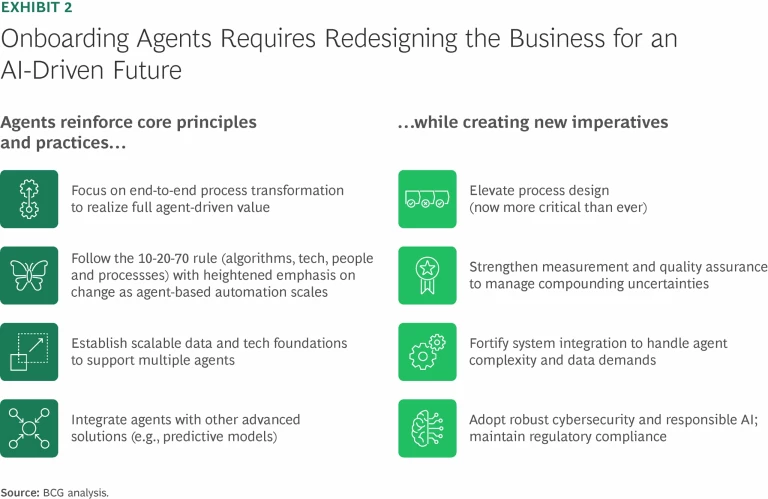You might call them the AI all-stars. The latest development in artificial intelligence capability, AI agents move beyond prediction and conversation to actually reshape business processes and get work done. They are distinguished from other forms of AI by their ability to act (under appropriate direction and supervision), executing tasks, achieving goals, and interacting with the real world. AI agents are powerful new tools that can help you achieve your most important business objectives.
AI Talks, Agents Walk
Following hard on the heels of generative, or conversational, AI, which introduced the ability to understand and generate human-like text and images, AI agents represent a far more powerful innovation. Conversational AI understands and responds. AI agents observe, understand, plan, and do. (See Exhibit 1.) Their indispensability is rooted in several key capabilities:
- Planning and Reasoning. Equipped with advanced reasoning capabilities, agents can break down complex goals into smaller, manageable tasks and develop plans to execute them.
- Action-Oriented Autonomy. Agents are built to operate with a degree of independence, established by human overseers, and to make decisions and take actions based on their goals and the environment. They can be designed to execute tasks autonomously or to operate under close human oversight, seeking approval before proceeding to the next step or taking a specific action. The degree of control can be adjusted over time, potentially increasing the agent's autonomy as confidence in its performance grows.
- Memory and Context. Agents can keep track of context over extended interactions, using past actions and information to inform future decisions. This enables them to handle complex, multistep workflows.
- Integration with Systems and Tools. Agents can connect to and use a wide range of software systems, tools, and data sources. This allows them to perform tasks that involve interacting with existing technology infrastructure.

Tech + Us: Harness the power of technology and AI
From Efficiency to Transformative Value
BCG has been working with clients since 2023 to build and implement AI agents. We have developed an open-source agent-building toolkit (AgentKit) used on more than 30 projects. In the course of this work, we have seen agents’ ability to act, unlocking transformative value far beyond simple automation. Our clients have achieved eye-opening results in these areas:
- R&D. A shipbuilding company used an autonomous, multiagent architecture with reasoning and planning capabilities to automate design tasks, reducing the engineering resources required by 45% and lead time per ship deck by 80%.
- Sales. A global logistics company used agents to automate its request-for-proposal response process, achieving 30% to 50% efficiency gains.
- Sales and Marketing. A large bank in Southeast Asia increased assets under management by 5% to 10% and increased customer conversions four- to sixfold using agents to provide relationship managers with real-time input for developing personalized offerings.
- Customer Engagement. A global cosmetics company reinvented the consumer experience and increased conversions five- to tenfold over traditional digital channels with a GenAI-powered beauty assistant.
- Supply Chain Management. A leading industrial goods company increased its EBIT margins by 3 to 10 points with an agent developed to run supply chain planning simulations, identify risks and their impact on operations, and propose mitigations.
What all these examples have in common is the use of AI agents able to reshape business processes, integrating previously siloed workflows and removing unnecessary steps regardless of organizational boundaries. Unlocking this transformative power requires a strategic, focused approach based on a company’s overall business objectives. It also means that the 10–20–70 rule—10% of the effort should be focused on algorithms, 20% on technology and data, and the remaining 70% on people and processes—is more relevant than ever. The importance of adhering to responsible AI practices increases as well, since agents will delve into the weeds of risk management and process integrity.
New Capabilities, New Complexities
Process redesign, therefore, lies at the heart of AI agents’ success. Onboarding agents requires addressing both the foundational principles behind processes and the emerging challenges that agents present.
Process Redesign. Automating a broken process will result in a broken outcome. AI agents necessitate rethinking workflows from the ground up, removing unnecessary steps, redefining roles, consolidating tasks, and ensuring that the underlying logic of the process is sound before it is automated.
Codification of Knowledge. AI agents operate on the basis of knowledge, meaning that organizations must explicitly define their version of the best practice for a process. This is particularly important in strategic and creative functions, where workflows are often informal and lack standardization.
System and Data Quality. AI agents derive their power from the ability to access multiple systems, but the effectiveness of their outputs depends entirely on the quality of those systems and the underlying data. The need for quality extends beyond clean, well-structured databases to the predictive models that agents rely on for decision making.
Risk Management and Testing. Unlike a single large or small language model, AI agents operate as multistep chains, often calling on multiple models in sequence or parallel. This capability is a big reason for agents’ power, but it also raises the stakes on responsible AI and significantly increases the complexity of testing, quality assurance, and risk management. Ensuring that the organization has in place robust capabilities for error handling and interpretability, as well as failsafe triggers and the ability to orchestrate and monitor the agents, becomes exponentially more challenging.
Integration. Agents need to be tailored to each company’s needs and circumstances. Still, off-the-shelf AI agent platforms can expedite deployment and reduce initial costs with installed workflow builders. The agents can then be customized for specific processes, objectives, proprietary data, and predictive models. Companies can focus internal development efforts on areas that differentiate their business and offer unique value to customers.
Embracing the Power of Agents
Bringing agents onboard is not about adopting a new technology; it’s about redesigning the business for an AI-driven future. (See Exhibit 2.) Companies need to embrace agents not as standalone tools but as fundamental enablers of efficiency, innovation, and growth. For most organizations, AI agents won’t be a sustainable source of competitive advantage on their own (but in time, they will become table stakes for organizational effectiveness). The true differentiation that agents offer lies the codification of essential processes, the quality of the underlying data, and the seamlessness with which they can be integrated into core processes and ways of working.

Organizations that successfully embed agents into their operational fabric by leveraging proprietary data, refining decision making, and focusing the new capabilities on achieving business objectives will create an enduring advantage that competitors can’t easily replicate.

















